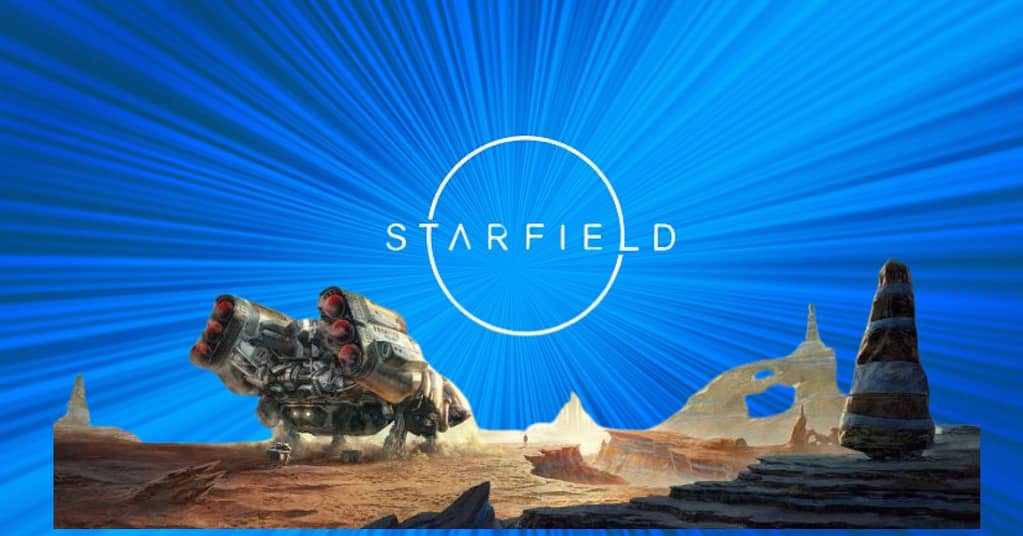Bethesda Game Studios, the creators of iconic titles like The Elder Scrolls and Fallout, have ventured into the realm of space with their latest release, Starfield. This highly anticipated RPG is Bethesda’s first new intellectual property in over 25 years, and fans have been eagerly waiting to see how the developer would bring its signature open-world experience to a galactic setting. In this comprehensive Starfield Game Review, we will break down its gameplay, story, graphics, and overall experience to see if it lives up to the hype.
Table of Contents
Introduction to Starfield
Starfield has been positioned as one of the most ambitious projects in recent gaming history. The game promises players the ability to explore a vast universe, engage in space battles, build their ships, and interact with a wide variety of NPCs across multiple planets. But with such high expectations, does Starfield deliver? This review will cover everything from the character creation process to the combat system, world-building, and the general atmosphere of the game.
The Plot: A Vast Galactic Adventure
At the core of Starfield is a rich narrative set in the year 2330, where humanity has expanded beyond Earth to colonize other star systems. Players take on the role of a customizable protagonist who stumbles upon ancient artifacts that hold the key to unraveling a deep cosmic mystery. This journey sends you through a universe filled with political intrigue, intergalactic factions, and ancient civilizations.
One of the game’s strengths is its non-linear storytelling. Players can choose to follow the main quest line or get lost in the vast array of side missions, each with its own unique story arcs and outcomes. The factions within the game – ranging from space pirates to scientific explorers – provide ample opportunities to tailor your experience. The choices you make in your interactions with these factions significantly impact the game’s narrative, making Starfield one of Bethesda’s most dynamic RPGs.
Gameplay: Exploring the Cosmos
The core gameplay of Starfield is a mix of exploration, combat, and resource management. One of the game’s standout features is the ability to explore over 1000 planets, each procedurally generated and filled with unique environments, resources, and wildlife. While this number seems overwhelming at first, the game strikes a balance by allowing players to decide how much time they want to dedicate to planetary exploration versus following the main quest.
Resource management plays a key role in the game. From mining asteroids to collecting rare elements on distant planets, Starfield encourages players to gather materials to upgrade their ships, weapons, and gear. This mechanic is reminiscent of No Man’s Sky but with Bethesda’s RPG twist.
Space travel is another highlight of Starfield. The game features a fully customizable ship system where players can build, upgrade, and pilot their ships across the galaxy. Ship-to-ship combat is fluid and engaging, and the customization options allow players to design ships that reflect their personal play style.

Character Creation and Progression
Bethesda is known for offering deep character creation systems, and Starfield is no different. Players can fully customize their characters, choosing everything from physical appearance to background stories. Your character’s background can have significant effects on gameplay, unlocking specific dialogue options, skills, and interactions with NPCs.
Progression in Starfield revolves around acquiring new skills and upgrading abilities as you explore the galaxy. The skill tree is expansive, offering perks related to combat, exploration, science, and diplomacy. One of the unique elements is how players unlock new abilities through completing specific in-game challenges, such as mastering certain weapons or engaging in particular space missions.
Combat: A Mix of First-Person and Space Battles
Combat in Starfield is a hybrid between first-person shooter mechanics and space battle simulations. On-foot combat is reminiscent of Bethesda’s Fallout series, with a focus on ranged weapons, melee attacks, and special abilities. The arsenal of weapons available is extensive, ranging from conventional firearms to futuristic energy weapons.
Space combat, on the other hand, offers a refreshing break from ground-based combat. Players engage in dogfights with enemy ships, utilizing their ship’s weapons, shields, and thrusters to outmaneuver foes. The customization of ships plays an important role here, as upgrading your ship’s armor, weapons, and engine can drastically change your combat effectiveness.
Graphics and World-Building
One of the most anticipated aspects of Starfield was its visuals, and the game certainly delivers. From the breathtaking views of distant galaxies to the detailed environments of alien planets, Starfield is a visual masterpiece. The attention to detail in everything from the character models to the design of the ships is impressive.
However, as with many Bethesda games, there are some graphical inconsistencies. While the space environments are jaw-dropping, certain planetary surfaces and NPC animations can feel slightly outdated. That being said, the game’s art direction more than makes up for these shortcomings, providing a unique and immersive experience.
The world-building in Starfield is also top-notch. The game’s universe feels alive with its diverse factions, NPCs, and environmental storytelling. Every planet and space station you visit has a sense of history, whether it’s abandoned research facilities or thriving spaceports. The game successfully captures the feeling of being a small part of a much larger universe, filled with mysteries waiting to be uncovered.
Sound and Music: Immersive and Atmospheric
The sound design in Starfield is nothing short of spectacular. The game’s soundtrack, composed by Inon Zur, perfectly complements the vastness and mystery of space. The music shifts seamlessly between atmospheric exploration tracks and intense battle themes, adding to the overall immersion of the game.
Voice acting is also a strong point, with a talented cast bringing the diverse range of NPCs to life. Whether you’re negotiating with alien diplomats or engaging in pirate skirmishes, the voice acting adds depth and realism to the interactions. The ambient sounds of space, from the hum of your ship’s engine to the eerie silence of a desolate moon, further enhance the game’s atmosphere.
Performance and Technical Aspects
While Starfield is a technical marvel in many respects, it is not without its flaws. Players on various platforms have reported occasional bugs, ranging from minor graphical glitches to more serious game-breaking issues. However, given Bethesda’s track record, it is likely that many of these issues will be addressed in future updates.
In terms of performance, the game runs smoothly on high-end PCs and the latest console hardware, but older systems may struggle to maintain consistent frame rates, especially during large-scale space battles or when exploring graphically intense planets.
Replayability and Player Freedom
One of the hallmarks of a Bethesda RPG is its replayability, and Starfield excels in this area. The vastness of the game’s universe means that no two playthroughs are the same. Players can choose to focus on different factions, explore new planets, or approach quests in multiple ways. The game’s dynamic quest system ensures that there are always new missions to undertake, even after completing the main story.
Player freedom is another strength of Starfield. Whether you want to be a heroic space explorer, a ruthless space pirate, or a neutral scientist, the game allows you to craft your own narrative. The choices you make throughout the game, both big and small, have lasting consequences, ensuring that your journey through the stars is uniquely your own.
Why is Starfield Poorly Reviewed?
While Starfield has received significant praise for its expansive universe, immersive storytelling, and deep gameplay mechanics, some reviews have been critical due to a few key factors. The game’s procedural generation system, which creates over 1,000 planets, has been viewed by some as a double-edged sword. While it allows for virtually endless exploration, some players have found certain planets to be repetitive or lacking in meaningful content.
Additionally, Starfield has faced criticism for technical issues, such as bugs and performance problems, particularly on older consoles or lower-end PCs. These issues, although expected in large open-world games, have led to frustrations among some players. Lastly, for fans of Bethesda’s previous titles, the game’s slower pace and focus on space exploration may feel like a departure from the more action-heavy experiences of Fallout or The Elder Scrolls series.
How Many Hours Will Starfield Be?
The length of Starfield largely depends on how much of the game you want to explore. The main storyline alone takes approximately 30 to 40 hours to complete. However, the true appeal of Starfield lies in its side quests, faction missions, and the sheer amount of content available for exploration. For players who wish to fully immerse themselves in the game by exploring different planets, completing side missions, and engaging in space combat, it’s not uncommon for playtime to exceed 100 hours or more.
Players aiming for full completion, including exploring all the planets and completing every quest, can expect Starfield to offer hundreds of hours of gameplay, making it one of Bethesda’s most expansive RPGs to date.
Is Starfield a Good Video Game?
Yes, Starfield is widely regarded as a good video game, especially for fans of open-world RPGs and space exploration. Its strength lies in its vast universe, engaging main story, and the freedom it offers players to explore and shape their own narrative. The ship customization and space combat mechanics are highlights for those looking for a game that blends exploration with strategic gameplay.
However, whether it’s considered “good” often depends on player expectations. Fans of fast-paced action may find Starfield slower compared to other titles, while those who enjoy immersive exploration and deep role-playing will likely appreciate the game’s intricate systems and galaxy-spanning adventures.
Was Starfield a Success?
Starfield has been a commercial success for Bethesda, with strong sales figures and high player engagement in its early weeks after release. The game generated considerable anticipation prior to launch, and it quickly became one of the most-played titles on platforms like Xbox Game Pass. However, success can be measured in different ways. While the game has sold well and garnered a dedicated player base, it has also faced mixed reviews due to some of the technical issues and gameplay design choices mentioned earlier.
Critically, Starfield has received both glowing praise and some less favorable feedback, so its overall success may depend on how well Bethesda addresses these concerns in future patches and updates.
Conclusion: A Worthy Starfield Game Review
In conclusion, Starfield is a monumental achievement for Bethesda. While it may not be perfect, with some minor bugs and graphical inconsistencies, the game’s ambition, depth, and immersive universe make it a must-play for any fan of RPGs or space exploration games. The combination of deep storytelling, expansive exploration, and engaging combat systems creates a memorable experience that will keep players coming back for more.
For those who have been waiting for a game that captures the wonder and mystery of space exploration, Starfield delivers in spades. Bethesda’s signature open-world design has successfully transitioned to the stars, and while the game may have a few rough edges, its potential is limitless. Whether you’re a seasoned RPG veteran or new to the genre, Starfield offers something for everyone.

